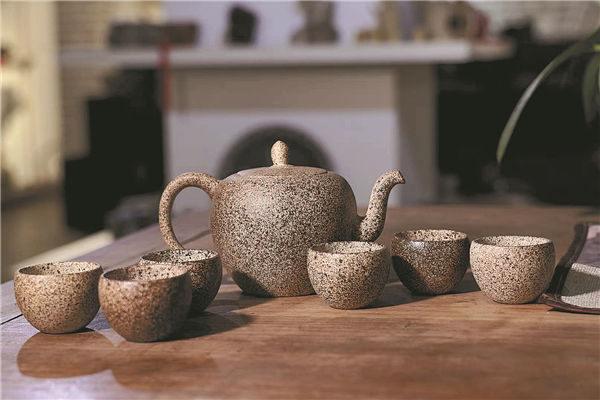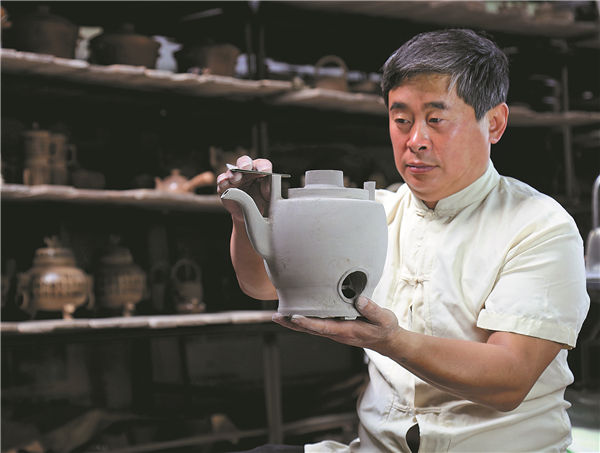All fired up

Zhang Hongliang has delivered many delicate earthenware items over the decades, such as a tea set. [Photo provided to China Daily]
Shanxi province craftsman displays a passion for preserving and innovating a millennia-old earthenware pottery style, Yang Feiyue and Sun Ruisheng report in Taiyuan.
An array of delicate earthenware, ranging from three-legged wine vessels to teapots and incense burners, adorn Zhang Hongliang's office in Pingding county, North China's Shanxi province.
Each piece exudes an artistic allure that captivates the eye and the mind.
They are made using historical Pingding earthenware craftsmanship that was named as a national intangible culture heritage by the State Council in 2014.
Zhang was named a national inheritor of the craft in 2018, and he has managed to transform the traditional earthenware, which was mostly rough, simple and utilitarian, into art.
"We have tried to combine techniques such as porcelain carving, lacquering, paper-cutting, calligraphy and painting to inject more vitality to Pingding earthenware," says Zhang, who has been engaged in local production and promotion of the craft for almost three decades.
"The variety of patterns and colors has also become increasingly diverse," he adds.
Zhang believes that such moves are important to ensure the sustainable development of Pingding earthenware, which carries a history of more than 2,000 years.
In 1972, a large number of earthenware fragments were excavated from a collapsed ancient kiln in the county, and experts confirmed they date back to the Qin Dynasty (221-206 BC).
The local pottery then became a popular handicraft during the Tang Dynasty (618-907), according to the Pingding County Annals published in the 1980s.

Zhang polishes an earthenware pot at his workshop in Pingding county, Shanxi province. [Photo provided to China Daily]
In the Qing Dynasty (1644-1911), Pingding earthenware was put on a pedestal after a widespread legend about Emperor Kangxi specifically asking for his medicine to be stewed in the pots.
"There's something to it," Zhang says.
"It is Pingding earthenware's strength in maintaining the stability of the medicine's properties, and preserving the original flavor and color of foods during cooking, that has made it so popular across the country," he adds.
Sitting in the middle section of the Taihang Mountains, Pingding is rich in mineral resources, of which large reserves of high-alumina soil, as well as refractory and siliceous clays, make excellent materials for producing earthenware.
The production process of Pingding earthenware is sophisticated, from material selection to the final glazing, each step requiring meticulous skill.
For example, the clay must be extracted 20 meters away from a local coal seam and be naturally weathered and refined.
"It has to be at the right balance of plasticity, malleability, and strength," Zhang says.
Arduous kneading is essential to increase the clay's stickiness and toughness.
The firing process is especially crucial, where the fuel and the earthenware must be precisely placed, and the temperature controlled accurately.
"The glazing process requires quick and exact movements to achieve the desired effect," Zhang says.
To date, Zhang has managed to develop more than 1,000 varieties of earthenware, and has restored the once-lost firing technique for thin-bodied items, the slimmest of which can be less than three millimeters.
"The earthenware that people see in daily life is generally thick and heavy to hold, but the fact is that, the thinner the earthenware, the better its permeability and thermal conductivity," Zhang explains.
Zhang experimented for three months and made his first thin-bodied teapot, but it exploded when he used it to boil water, spraying the hot liquid everywhere.

Zhang Hongliang has delivered many delicate earthenware items over the decades, such as an eagle-shaped wine dispenser. [Photo provided to China Daily]
"It was really dangerous, but I wasn't scared and just wanted to keep going," he says.
It wasn't until three years later, after much trial and error, that he finally pulled it off.
"When using such a pot to stew or cook food, the taste will be particularly rich and thick," he adds.
Born into a family of ceramic artists, Zhang developed a strong interest in earthenware as a child, especially under the influence of his father who was a provincial master of arts and crafts in Shanxi, and an inheritor of Pingding engraved porcelain.
In the early 1990s, Zhang started to study porcelain manufacture at a local plant, where he built a solid foundation for his craft.
As time moved on, Zhang saw many craftsmen switch profession, and witnessed many kilns grow cold.
"At that time, Pingding earthenware products were regarded as just ordinary utensils, such as pots and medicine jars," he recalls.
When modern kitchenware flooded the market, many local craftsmen believed that this industry had no future," he recalls.
Yet, he believed the craftsmanship that has been passed down for thousands of years could have new vitality.
In 1996, he founded his own pottery workshop and has since committed himself to the rescue and inheritance of the traditional craft.
In 2002, a businessman from the Netherlands came to Pingding looking for local earthenware, but requested that it featured a large, round opening; a small, thin bottom, and a smooth surface.
It was higher than local standards allowed for, and Zhang invited the best craftsmen to help meet the requirements, but eventually the effort was in vain.
There were very few written records on Pingding earthenware production available for reference, so Zhang had to test every step of the way. He built more than 10 kilns, one after another, trying and failing repeatedly, almost bankrupting himself in the process.
However, he didn't give up and carried on. After over 1,000 experiments, Zhang eventually delivered more than 6,000 items, all of which met the expectations of the Dutch customer.
"Although I didn't make much money, I achieved dignity and hope for Pingding earthenware," he says.
The successful deal further strengthened Zhang's confidence in innovation. After continuous research, he developed a glaze spray sandblasting process, a groundbreaking move that rendered the earthenware's glazed color and thus improved its quality and black appearance.
"When combining the techniques of porcelain carving with earthenware, it was really difficult during the experimentation stage," Zhang recalls, adding that there was no precedent for the earthenware to have a glazed color.
Due to the different materials and firing methods, the two crafts were incompatible.
"If the glaze color is enhanced, it will cause the earthenware body to deform or even collapse, but if the body shape is ensured, the glaze color will become dirty or scarred," he says.
It was his father that helped him deliver the impossible.
"He encouraged me to go on and believed the idea of combining the two crafts was valuable," Zhang says.
After experimenting for five years, Zhang finally succeeded. His finished products received high recognition within the industry.
Zhang didn't rest on his laurels, and has continuously experimented with new techniques and recipes to add even more enhancements, both decorative and functional, to his earthenware products.
Now, his workshop can produce more than 700,000 Pingding earthenware items a year, many of which make their way to Japan, South Korea and the Netherlands.

Zhang Hongliang has delivered many delicate earthenware items over the decades, such as a square cup decorated with four rams. [Photo provided to China Daily]
In addition to perfecting the craftsmanship, Zhang has made a special effort to promote the historical art.
For the past 15 years, Zhang has traveled to many earthenware production regions across the country to learn about their crafts and collect related items.
In 2019, Zhang established an earthenware museum, which has displayed items from Pingding and other areas of the country, including production tools, molds, account ledgers, as well as text and photos from the county's ceramic factory which was set up in 1958.
The move is out of his concerns for the inheritance of the traditional craft.
"It is difficult to cultivate successors, as it requires a lot of time to pick up the related skills," Zhang says.
"Second, fewer young people are willing to engage in the trade, which is arduous," he adds.
The museum has enabled local students to experience and develop an interest in the earthenware firsthand.
"They have to appreciate its charm and come to like it before they can voluntarily continue the tradition," Zhang says.
To help more people understand Pingding earthenware, in 2019 Zhang started to showcase the manufacturing process of sand pottery on the short-video platform Kuaishou.
To date, he has posted more than 400 short videos and delivered in excess of 100 livestream broadcasts, which helped him to gain more than 100,000 followers.
Wang Xia from Hebei province purchased several Pingding earthenware items for brewing and drinking tea after seeing Zhang's performance.
"It's amazing how ordinary clay can become a work of art in the hands of a master," Wang says.
Speaking about his future plans, Zhang says he wants more people to see the charm of earthenware.
"The path of inheritance is endless, and my dream is to carry forward the Pingding earthenware craft and bring it to the world's attention."





